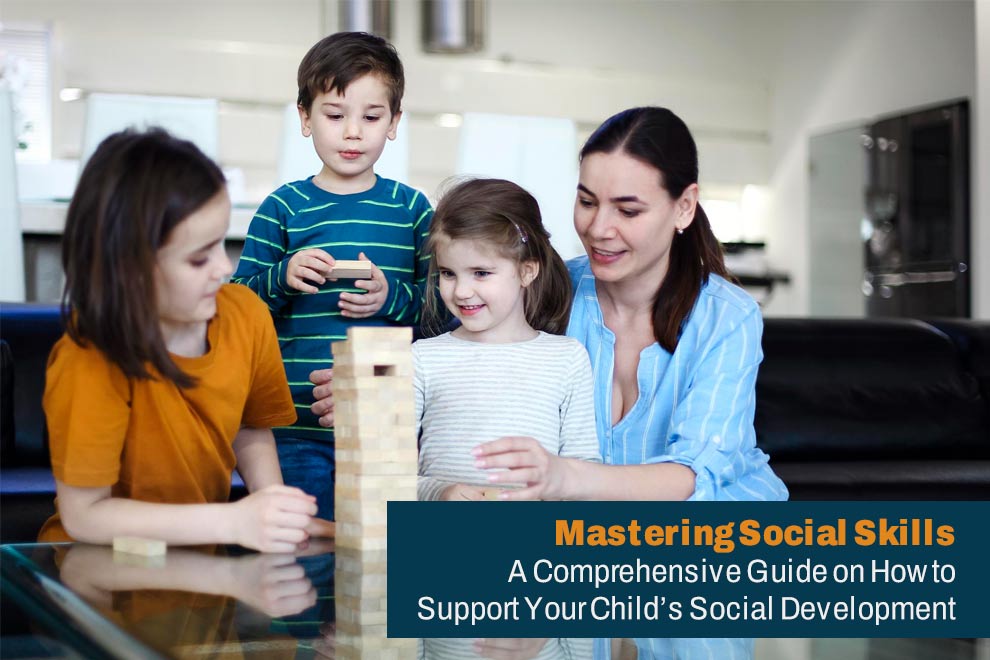Your child is stepping into a room full of kids, chatting easily and making friends without a second thought. That confidence doesn’t just happen. It builds from strong social skills that help kids succeed in school, stay mentally healthy, and even land better jobs later in life.
Social competence goes way beyond fitting in at recess. It shapes how children handle emotions, work with others, and build lasting bonds. In this guide, you’ll find real, backed-by-research ways to help your child grow empathy, sharpen communication, and form solid peer ties. We’ll cover tips for every age, from toddlers to teens, so you can guide them toward a brighter social future.
Nurture your child’s social development at our daycare in Paramus, NJ. Our comprehensive guide will help your child thrive in forming positive relationships and communication skills. Enroll now to support your child’s social growth
Understanding the Milestones of Social Growth
Kids hit social steps at different times, but knowing the basics lets you spot what’s normal and where to step in. These milestones show how children move from playing alone to teaming up with others. Parents who track them can offer the right nudge at the right moment.
Early Markers: From Parallel Play to Turn-Taking (Ages 1-4)
Toddlers often play side by side without much talk. That’s parallel play, a first step in social development. By age three, they start sharing toys and taking turns, which builds basic trust.
Watch for cues like a smile during play or frustration when sharing breaks. If your child grabs toys without asking, gently guide them to say “my turn.” Studies from child experts show that early sharing practice cuts down tantrums by up to 40% in preschoolers.
These years lay the groundwork for empathy. Praise small wins, like waiting for a swing. It helps them see others’ feelings as real.
School-Age Social Landscapes: Friendships and Group Dynamics (Ages 5-10)
At this stage, kids crave real friends who like the same games. Reciprocal friendships mean give-and-take, not just one-sided play. They learn rules like no cutting in line during games.
Group play teaches loyalty and handling small fights. A child might argue over a ball but learn to say sorry and move on. Digital tools, like kid-safe apps, add a layer—teach them kind online chats early to avoid mix-ups.
Research from the American Academy of Pediatrics notes that strong peer ties here boost school grades by 20%. Encourage invites to birthday parties. It strengthens those bonds.
Navigating the Complexities of Adolescence
Teens face bigger crowds and stronger peer pull. They seek groups where they fit in, often testing limits to belong. Social ranks can feel like a jungle, with cliques forming fast.
Digital chats amp up the mix—texts and posts shape views quick. Help them spot fake friends or mean posts. Face-to-face talks still matter most for deep ties.
Experts say balanced social lives cut teen stress by half. Guide them through heartbreaks with calm chats. It builds skills for adult relationships.
Cultivating Core Social Competencies at Home
Home is the best lab for social skills. You set the tone by what you do and say each day. Simple habits here create kids who connect well anywhere.
Teaching Empathetic Responding and Perspective-Taking
Empathy means feeling what others feel. Start by talking about book characters’ moods. Ask, “How do you think the puppy felt when left alone?”
Theory of Mind is key—it’s grasping that others think differently. Role-play: Pretend you’re the sibling who lost a toy. Let your child guess your sad feelings.
- Read stories together and pause to discuss emotions.
- Use mirrors to practice facial cues, like a happy grin.
- Praise when they comfort a upset family member.
These steps, per child psychology studies, raise empathy scores in kids by 30%. Practice daily for real change.
Mastering Verbal and Non-Verbal Communication
Clear talk and body signs prevent mix-ups. Teach eye contact and nods for listening. It shows you’re tuned in.
Assertive words help express needs without yelling. Use “I feel sad when you take my book” instead of blame. Practice in calm moments.
Here’s a quick example: During dinner, if a child interrupts, model waiting. Say, “I hear you, but let’s finish my story first.” Non-verbal tips include open arms for welcome vibes.
Kids who learn this early handle talks better, says research from Harvard. It cuts playground spats in half.
The Art of Conflict Resolution
Fights happen, but teach kids to fix them. Don’t just pull them apart—show steps to solve issues.
First, name the problem: “You both want the red truck.” Then, brainstorm fixes like taking turns. Pick one and try it.
- Step 1: Calm down with deep breaths.
- Step 2: Share feelings without blame.
- Step 3: Find a fair fix together.
Family trials build confidence. One study found kids trained this way resolve 60% more disputes on their own. Keep it light and repeat often.
Creating Rich Environments for Social Practice
Real practice happens outside quiet home time. Set up spots where kids must interact. It turns skills into habits.
Leveraging Structured Playdates and Group Activities
Plan playdates with a start and end time, like 3 to 5 p.m. Pick activities such as board games to spark talk.
Team sports or classes like art clubs force teamwork. Soccer teaches passing and cheering losses. Drama builds expression through roles.
- Set rules upfront: No hitting, share tools.
- Watch from afar but join if needed.
- End with thanks to build manners.
These setups, backed by play therapy pros, improve social ease by 50% in shy kids. Make them regular fun.
Utilizing Unstructured Social Time Effectively
Parks let kids start chats on their own. Swing sets or sandboxes invite “Want to build a castle?”
Step back but stay close. If they freeze, whisper starters like “Ask about their dog.” It eases nerves.
Community spots mix ages and styles. One park visit a week adds variety. Watch how they adapt—it shows growth.
Unstructured time sparks creativity in bonds, per child development reports. Let them lead most days.
The Role of Family Dynamics in Social Rehearsal
Family meals mimic group talks. Pass food while sharing day highlights. It practices waiting and listening.
Debate lightly, like best ice cream flavors. Respect differing views. It models fair play.
- Turn off screens for full focus.
- Ask open questions: “What made you laugh today?”
- Include everyone, even quiet ones.
Strong family ties predict better peer skills, says a Yale study. Use dinners as free practice.
Addressing Common Social Challenges and Stumbling Blocks
Not every day goes smooth. Spot issues early and guide gently. It keeps small bumps from growing big.
Supporting the Socially Hesitant or Shy Child
Shy kids need time, not push. Introverts recharge alone; anxiety needs more help. Talk to a doc if it lasts.
Ease in with short meetups. Give scripts: “Hi, I’m Alex. Like trucks?” It lowers fear.
Psych pros suggest gradual steps build comfort. Praise efforts, not just wins. One mom saw her son join games after weeks of practice.
Identifying and Responding to Social Exclusion or Bullying
If kids leave yours out, listen without fixing fast. Say, “That hurts—I get it.” Plan responses like finding new pals.
For bullies, teach firm no’s and tell adults. Role-play comebacks: “Stop that, please.” Empower them to act.
Never ignore signs like withdrawn moods. Schools report 25% of kids face this; quick talks help. Build their voice step by step.
Recognizing Signs of Social Overwhelm
Too much chatter tires some kids. Watch for crankiness or hiding. They need breaks.
Teach self-checks: “Do I feel buzzy? Time to read alone.” Sensory spots like quiet corners work.
Balance social days with calm ones. Child experts note rest prevents meltdowns. Tune into their limits.
Conclusion: Nurturing Future Connected Adults
Social growth shapes who your child becomes. Key moves include modeling empathy daily, setting up practice spots, and always validating their feelings. These build a base for strong ties.
Patience matters—it’s a slow build, not overnight magic. With your steady lead, kids turn into adults who connect deep and handle life’s curves.
Start today: Pick one tip, like a family chat night. Watch the bonds grow. Your support makes all the difference.
Also Read: Social Change as a Career: Paths, Skills, and Opportunities











